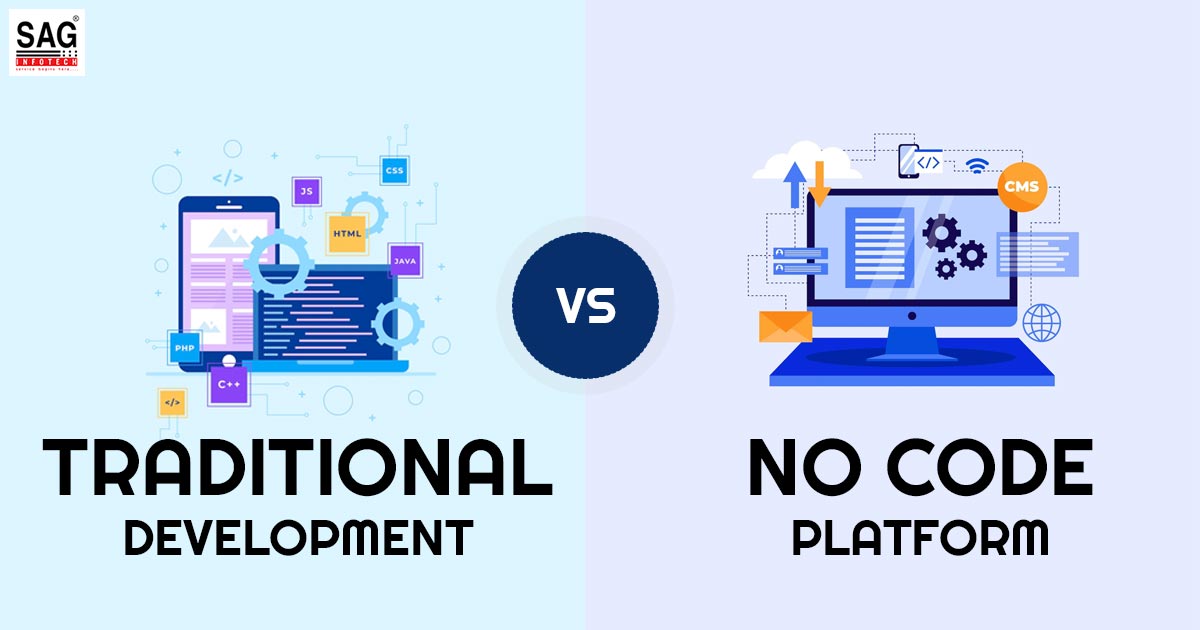
No-code development and traditional software development would be in competition. The former software development comprises of onsite/offshore team of developers and building coders, developing and maintaining the product. The whole industry has been developed by supporting the firms that made their product via distant teams. Since the evolution of no code, the major appeal of offshore development i.e the cost base efficiency would get vanishing. Hence the article compares the former onsite development with no code development.
With the rate of $115 per month, some no-code platforms could cost less than the former development. Through this barometer, no code tools overcome the former development on any specified day in the year. However, there would be much more to the development of the application as compared to the cost of development and to learn the applied cost of the no-code platform vs onsite traditional software we shall learn in depth.
Price of Traditional Development
Excluding precisely enlisting the operations, workflow, deployment schedule, and third-party integrations, estimating forms of costs is just like shooting an arrow in the dark. However, you are required to build an operational enterprise-grade application. Irrespective of the onsite development partner you opt for, the partner’s perspective cost will rely on the salaries proposed to the developers engaged in the project.
The available information specifies that the Junior developers in onsite arrangements would be paid $110 for an hour. The time taken will be between 300-500 hours to make the enterprise-grade application operational, which draws the cost of development for an application to approximately $35,000.
In the initial time, the same may be the finish of the calculation. However those who would make the enterprise-grade application onsite will know there are fixed, recurring, and cost of expanding which arrives with onsite traditional development.
After Application Development, You Would Know the Fee
- Quality Assurance Fees: QA & Testing are costs summed on top of development.
- Database Related Fees: When you decided to maintain the growth app then you shall require a database engineer on regular grounds.
- Third-Party Licenses & Integrations: towards each integration, you pay the developer for an hour or even need to pay for the licensing fees.
- Onsite Team Recruitment & Salary Expenses: You would hire the consultants who support you to hire and retain full-time IT, development, and engineering talent.
- Onsite or Cloud Storage Agreements: With the progress of the application development lifecycle you have required contracts with Microsoft Azure, AWS, Salesforce, Google, or one of the other cloud providers.
- Update & Codebase Keeping: As the app starts functioning you are required an onsite developer to maintain the codebase and handle updates.
Advantages of Traditional Development
While the arrangement would be consuming the resource, traditional onsite development has its advantages.
- Access to Codebase & Ownership: The ownership shall always be maintained by the company of and access to the codebase assists in maintaining the standards of security and intellectual property rights.
- Scalable Architecture: The initial cost of building the team, cloud infrastructure, licenses and integrations, and additional kinds of stuff rendered that your app would be ready to get expand for some months.
- Feature of Custom Engineering: Whether the same feature trends in your target market or told by your sales team to revise the experience of the customer your own team would assist you to execute the same.
- Ready to Utilize Product at Launch: The onsite apps sometimes have a monolithic architecture and would be launched as finished products from the first day with incremental releases planned for subsequent times.
- Streamlined Communication: When your management team adores facetime with the development team before handing over the buy-in, onsite traditional development will be of great appeal to your culture.
Hurdles of Onsite Traditional Development
The onsite traditional development arrives with its inherent shortcomings which add to the costs.
- High-Risk Task Lifecycle: The onsite development needs upfront human capital, infrastructure, cloud, and licenses. These investments open unit economic efficiencies if the product would enhance at a quicker pace, if the product has not been tested yet in the target market then they take a higher risk. When the cost is made then they would be attached as a liability no matter what will be the performance of the product.
- Ongoing Liability: Integration, security, and updates obligations are drawn in the house. The same makes pressure on the profits of the product as the business invests to maintain the product.
- Distracting Aid Allocation: When your business is mainly performing in a non-tech industry, developing the company apps in-house is rendered towards providing manager or supervisory resources out of your capability.
- Costs of Vendor: Vendor outreach, filtering, locking, negotiation, onboarding, and retention obligations are handled in-house.
- Errors & Omissions Menace: As the complete development has been performed in-house, hence the company is responsible for any menace which would arrive beneath the category of errors and omissions under the applications.
Indicated & Effective Fee of No Code Software Development
To this effect, a low-code no-code platform costs a fraction of the whole offshore development costs that cost a fraction of the traditional onsite development costs. It mentioned the cost of a no-code is needed to be considered.
- No Code Platform Fees: Relying on the simpler utilization, access to functionalities, range of templates, and other available resources, the cost of a subscription to a no-code platform could rise up to $2000 for the whole year.
- Cloud Deployment Prices: After the development of the app the same required the backend support, databases, and documentation which is hosted on the cloud.
- No-Code Developer Fees: Johannessen and Davenport have proposed the process, and recommend utilizing a development resource including a no-code platform. The citizen-professional developer arrangement justifies the gap in the limitations of No Code procedures. But the other developer needs to be summed to the cost base.
- Care & Scaling Expenses: After the application would get tested and launched you seek to expand the same. While it expands a higher delicate architecture is needed that might have intended to draw additional resources.
Advantages of Development By No-Code Platform
A no-code platform development draws a considerable degree of efficiency for the development:
- Deployment of Accelerated: You moved from an idea to a working prototype in case of hours rather than weeks. Through visual programming or the specification of drag and drop, you could attain the same speed without excusing the workflows you made.
- Individual Sustaining Product Lifecycle: When the business model which supports the application is reliable and stronger then you could virtually offset the whole cost of development and expansion with the coming revenues. The break-even point is accessible as the cost invested does not run in hundreds of thousands of dollars.
- Mitigated Aid Allocation: Opposite to the onsite development the no-code development does not ask for upfront resource allocation. As soon as the product in the market is known to people and the feedback is collected you could increase the resource allocation system and reduce the issues of excess allocation.
- Improved Focus on Core Competencies: Excluding working on the code base, a no-code permits the citizen developers to conceptualize the core idea. The same diminishes the mutual complaint that no code apps would unable to do.
- Inclusive Method: When the agreement of various stakeholders would be essential for success to come then no code, is likely to arrive on every decision maker to contribute to the project rather than making observational comments.
Read Also: Best 15 Low-Code No-Code Platforms for Small Business
No-Code Development Hurdles
Even after getting the much more benefits. There is no code development tool that arrives with the challenges.
- Limited Design & Features Scope: Various no-code tools furnish, a range of design templates and features. But the same library will have a limit and thus might not be set as per your ideas.
- Scalability Challenges: Your app will no more get enhanced and expands until you move towards the codebase-led central repository of data, environment, and code. Thus at a point, you shall require a professional to develop the app.
- Dependencies: You laid on the citizen developer along with the platform utilised through this person. the citizen developer may be the only person who learns about the workflow in a good way, there will be no documentation or codebase available. But you need to assume, that the platform utilised for practising is available in the near future.
- Control to Security and Codebase: As there would be no code base in the initial place you do not need the intellectual property rights for code. The majority of the no-code tools propose effective baseline security. The same is hard to go above the standards for your apps.
Difference Between Traditional and No-code Platform Development
| Onsite Development | No-code Platform |
|---|---|
| Codebase Ownership | Accelerated Development |
| Scalable Architecture | Self-Sustaining Product Lifecycle |
| Custom Feature Engineering | Mitigated Resource Allocation |
| Ready-to-Deploy Product | Leverage Core Competencies |
| Streamlined Communication | Inclusive Process |
Closure
A no-code development takes less investment as compared to onsite traditional development. The no-code tool procedure would be more user-friendly and can be deployed within lesser time while onsite development needs a prior commitment of the resources in the development raising the risk quotient.
But the main thing to learn is if the no-code development proved to be effective despite having a cheaper value.
We need to build a faster and quicker test to assist you with the answer. The outcome is principled, tailored as per your reply, and chooses less than 2 min for you to finish. Tap here to learn if the less cost of the no-code development is correct for your project or not.
Have You Heard About the Upcoming SDMT Low Code No-code Platform?
SAG Infotech has been working on Smart Development and Management Tool (SDMT) for the last 7-8 years and soon this feature-packed utility will make its way to the real world.
SDMT is a unified tool for building all applications including website, desktop, online, and mobile on a single platform. All development work will be handled by SDMT.
With this on SDMT low code no code platform a user has to simply access the dashboard and check the menu bar there, all the codes and tools will be visible, and then the user has to select the options and tools from the list and apply them to their project.
This platform will result in a 60% reduction in manpower cost and a 50% reduction in turnaround time for users looking for web and app developers. The platform is solving various problems like manpower, different programming languages, changing technologies, and more from the current IT sector.
SDMT is primarily built on Java and has all the practical features of a framework, code management, IDE, testing and development tools. With this, there will be no need for any third-party software. With auto code generation functionality for all OSs and devices, it eliminates the need of developing different apps for different platforms.
SDMT differs from Low-Code Application Platform (LCAP) because SDMT provides access to the source code; covers the whole process of application development and management; and supports multiple programming languages and databases.









Amazing